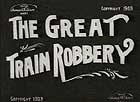| The Great Train Robbery (1903) | |
| Background
The precursor to the western film genre was based on an 1896 story by Scott Marble. The film's title was also the same as a popular contemporary stage melodrama. It was the most popular and commercially successful film of the pre-nickelodeon era, and established the notion that film could be a commercially-viable medium. The film was originally advertised as "a faithful duplication of the genuine 'Hold Ups' made famous by various outlaw bands in the far West." The plot was inspired by a true event that occurred on August 29, 1900, when four members of George Leroy Parker's (Butch Cassidy) 'Hole in the Wall' gang halted the No. 3 train on the Union Pacific Railroad tracks toward Table Rock, Wyoming. The bandits forced the conductor to uncouple the passenger cars from the rest of the train and then blew up the safe in the mail car to escape with about $5,000 in cash. The film used a number of innovative techniques, many of them for the first time, including parallel editing, minor camera movement, location shooting and less stage-bound camera placement. Jump-cuts or cross-cuts were a new, sophisticated editing technique, showing two separate lines of action or events happening continuously at identical times but in different places. The film is intercut from the bandits beating up the telegraph operator (scene one) to the operator's daughter discovering her father (scene ten), to the operator's recruitment of a dance hall posse (scene eleven), to the bandits being pursued (scene twelve), and splitting up the booty and having a final shoot-out (scene thirteen). The film also employed the first pan shots (in scenes eight and nine), and the use of an ellipsis (in scene eleven). Rather than follow the telegraph operator to the dance, the film cut directly to the dance where the telegraph operator enters. It was also the first film in which gunshots forced someone to dance (in scene eleven) - an oft-repeated, cliched action in many westerns. And the spectacle of the fireman (replaced by a dummy with a jump cut in scene four) being thrown off the moving train was a first in screen history. In the film's fourteen scenes, a narrative story with multiple plot lines was told - with elements that were copied repeatedly afterwards by future westerns - of a train holdup with six-shooters, a daring robbery accompanied by violence and death, a hastily-assembled posse's chase on horseback after the fleeing bandits, and the apprehension of the desperadoes after a showdown in the woods. The steam locomotive always provided a point of reference from different filming perspectives. The first cowboy star, Gilbert M. 'Broncho Billy' Anderson played several roles: a bandit, a passenger who was shot in the back, and a tenderfoot dancer. The remarkable film was greeted with the same kind of fanfare that Sam Peckinpah's violent The Wild Bunch (1969) received many years later. Plot Synopsis
The action of each scene is told with only one shot. Almost every shot is a static, long shot, confining the action to the perspective of the camera at eye level. Tension and excitement is achieved by moving the players, rather than moving the camera angles. Beginning/Ending: The ending (or the beginning - it was interchangeable) helped place the film in history books - a gun was pointed straight at the audience by a bandit and fired right in their faces to startle them. (see end of film) Scene 1: The interior of the railroad telegraph office:
The bandits hide behind the water tower near the station as the train slowly pulls up and takes on water - due to the false order. The desperadoes stealthily sneak on board the train (between the tender, the car attached to the steam locomotive that carries fuel and water, and the express mail car) just before it pulls away. Scene 3: Side view of the interior of the express mailcar:
Scene 4: The tender and the interior of the locomotive cab, looking toward the front of the train:
At gunpoint, the engineer is forced to leave the locomotive, and walk back to uncouple the locomotive from the rest of the passenger cars. They walk back to the front of the train and board the locomotive. The engineer is forced to pull the train ahead about 100 feet, leaving the rest of the cars behind. Scene 6: An exterior scene showing the coach section of the train - the holdup.
Scene 7: The bandits board the locomotive and leave the scene of the holdup: The bandits board the locomotive with large bags of valuables. They force the engineer to start the train and move off into the distance to the left. |